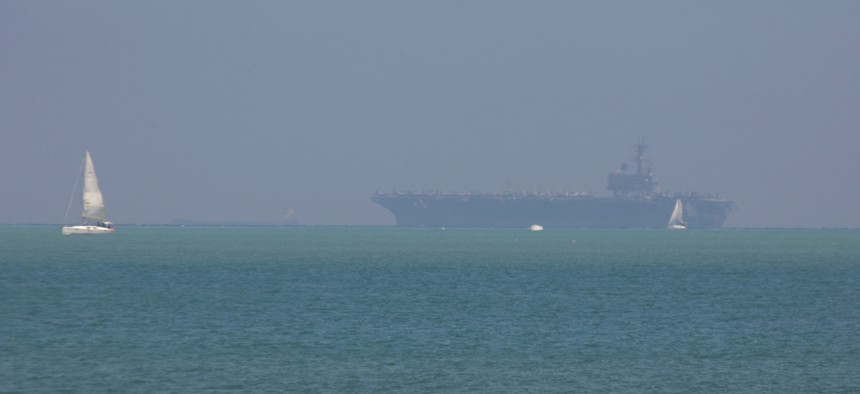
The United States' Navy USS George H.W. Bush aircraft carrier docks in the Mediterranean Sea off the coast of Haifa, Israel, Saturday, July 1, 2017. AP Photo/Ariel Schalit
The Eastern Mediterranean Needs More US Warships
Regional tensions and distracted allies underscore the need for more naval presence.
As tensions rise in the Black Sea to its north and Persian Gulf to the southeast, the Eastern Mediterranean is often an afterthought for American defense planning, despite its geostrategic importance as a crossroads between Europe, the Middle East, and North Africa. For the first time since 2016, the U.S. Navy recently deployed two Nimitz-class aircraft carriers to the region in April. This was an important signal to America’s partners and adversaries, but more needs to be done to strengthen the U.S. Navy’s presence in these increasingly contested waters.
Russia has established a permanent presence in the Eastern Mediterranean by leasing a naval base in Tartus, Syria; it has deployed naval assets and S-400 anti-aircraft systems to Syria and provided Assad with S-300s of his own. The ultimate effect of these moves on American or Israeli freedom of action is debatable, but Moscow’s message is clear: it’s back and here to stay.
Iran also seeks to cement its forces along the Mediterranean. It is set to begin leasing part of the port in Latakia in October, which could help smuggle weaponry into Syria and ultimately threaten Israel and the U.S. Sixth Fleet’s freedom of navigation. Indeed, Tehran, through Hezbollah in Lebanon, can already threaten shipping and offshore energy infrastructure.
Energy discoveries off Israel, Egypt, and Cyprus could deepen existing rivalries and generate new ones. Syria’s Assad may look to the Mediterranean to boost trade revenues and energy resources as he works to rebuild his country. Hezbollah in Lebanon could use offshore energy disputes with Israel as a pretext for conflict.
Related: Turkey Made a Bet Against Assad—And Lost
Related: Top US Officer: Iran’s Threats Look Like a ‘Campaign’
Related: US and Russia Regard Each Other Warily in the Baltic and Black Seas
And Turkey increasingly sees itself as a regional naval power in competition with Greece and Cyprus.
America’s current naval posture in the Eastern Mediterranean is not large or sustained enough to address the region’s increasing competition. The U.S. Navy homeports a few destroyers in Spain and a single amphibious command ship in Italy. Battle groups typically make port visits throughout the region as they transit to and from the Persian Gulf — unless, as happened earlier this week, they are hustled over to the Gulf to deal with rising tensions there.
And NATO navies are not focused on regional deterrence, despite the growing presence of Russia and Iran, being absorbed with continued flows of migrants and refugees to Europe from North Africa and the Middle East.
However, the U.S. can take several steps to improve its force posture in the region.
First, the Pentagon should use its Dynamic Force Employment model to maintain deterrent force presence in the region by allocating more ship days to the Eastern Mediterranean. Since this model allows naval forces to deploy in unpredictable force structures or locations, adversaries are less able to prepare for aggressive action in the region. By increasing deployment flexibility, the Navy can more readily respond to crises as they develop and can capitalize on strategic opportunities.
Second, the U.S. Navy should use these extra ship-days to increase the frequency and duration of port visits of EUCOM naval vessels to partner nations in the region. These visits have the dual benefit of strengthening America’s relationship with its allies while deterring its adversaries.
Third, Washington should help regional allies improve their own capabilities and presence in the Eastern Mediterranean. The Navy should combine an increased presence in the Eastern Mediterranean with an expansion of multinational training focused on countering Russian and Iranian forces in the region. The U.S. should also provide more excess vessels and other arms and defense gear.
For the first time since the Cold War, the Eastern Mediterranean is a center of complicated challenges both for the United States and its allies. As adversaries seek to exploit the region’s economic potential and political instability, visible American presence will be crucial to confront these challenges.
NEXT STORY: New, More Usable Nukes for Trump? No.



